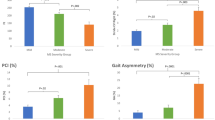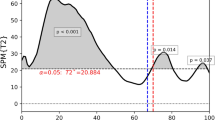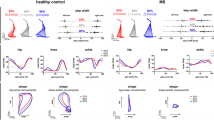Abstract
Prolonged walking is typically impaired among people with multiple sclerosis (pwMS), however, it is unclear what the contributing factors are or how to evaluate this deterioration. We aimed to determine which gait features become worse during sustained walking and to examine the clinical correlates of gait fatigability in pwMS. Fifty-eight pwMS performed the 6-min walk test while wearing body-fixed sensors. Multiple gait domains (e.g., pace, rhythm, variability, asymmetry and complexity) were compared across each minute of the test and between mild- and moderate-disability patient groups. Associations between the decline in gait performance (i.e., gait fatigability) and patient-reported gait disability, fatigue and falls were also determined. Cadence, stride time variability, stride regularity, step regularity and gait complexity significantly deteriorated during the test. In contrast, somewhat surprisingly, gait speed and swing time asymmetry did not change. As expected, subjects with moderate disability (n = 24) walked more poorly in most gait domains compared to the mild-disability group (n = 34). Interestingly, a group × fatigue interaction effect was observed for cadence and gait complexity; these measures decreased over time in the moderate-disability group, but not in the mild group. Gait fatigability rate was significantly correlated with physical fatigue, gait disability, and fall history. These findings suggest that sustained walking affects specific aspects of gait, which can be used as markers for fatigability in MS. This effect on gait depends on the degree of disability, and may increase fall risk in pwMS. To more fully understand and monitor correlates that reflect everyday walking in pwMS, multiple domains of gait should be quantified.


Similar content being viewed by others
Reference
Motl RW (2013) Ambulation and multiple sclerosis. Phys Med Rehabil Clin N Am 24:325–336
Bouchard V, Duquette P, Mayo NE (2017) Path to illness intrusiveness: what symptoms affect the life of people living with multiple sclerosis? Arch Phys Med Rehabil 98:1357–1365
Barin L, Salmen A, Disanto G, Babacic H, Calabrese P, Chan A, Kamm CP, Kesselring J, Kuhle J, Gobbi C, Pot C, Puhan MA, von Wyl V (2018) The disease burden of multiple sclerosis from the individual and population perspective: which symptoms matter most? Mult Scler Relat Disord 25:112–121
Stellmann JP, Neuhaus A, Gotze N, Briken S, Lederer C, Schimpl M, Heesen C, Daumer M (2015) Ecological validity of walking capacity tests in multiple sclerosis. PLoS ONE 10:e0123822
Motl RW, Pilutti L, Sandroff BM, Dlugonski D, Sosnoff JJ, Pula JH (2013) Accelerometry as a measure of walking behavior in multiple sclerosis. Acta Neurol Scand 127:384–390
Kieseier BC, Pozzilli C (2012) Assessing walking disability in multiple sclerosis. Mult Scler 18:914–924
Goldman MD, Marrie RA, Cohen JA (2008) Evaluation of the six-minute walk in multiple sclerosis subjects and healthy controls. Mult Scler 14:383–390
Butland RJ, Pang J, Gross ER, Woodcock AA, Geddes DM (1982) Two-, six-, and 12-minute walking tests in respiratory disease. Br Med J (Clin Res Ed) 284:1607–1608
Sandroff BM, Pilutti LA, Motl RW (2015) Does the six-minute walk test measure walking performance or physical fitness in persons with multiple sclerosis? NeuroRehabilitation 37:149–155
Pilutti LA, Dlugonski D, Sandroff BM, Suh Y, Pula JH, Sosnoff JJ, Motl RW (2013) Gait and six-minute walk performance in persons with multiple sclerosis. J Neurol Sci 334:72–76
Burschka JM, Keune PM, Menge U, Hofstadt-van OU, Oschmann P, Hoos O (2012) An exploration of impaired walking dynamics and fatigue in multiple sclerosis. BMC Neurol 12:161
Kluger BM, Krupp LB, Enoka RM (2013) Fatigue and fatigability in neurologic illnesses: proposal for a unified taxonomy. Neurology 80:409–416
Lord S, Galna B, Rochester L (2013) Moving forward on gait measurement: toward a more refined approach. Mov Disord 28:1534–1543
van der Linden ML, Andreopoulou G, Scopes J, Hooper JE, Mercer TH (2018) Ankle kinematics and temporal gait characteristics over the duration of a 6-minute walk test in people with multiple sclerosis who experience foot Drop. Rehabil Res Pract 2018:1260852
Socie MJ, Motl RW, Sosnoff JJ (2014) Examination of spatiotemporal gait parameters during the 6-min walk in individuals with multiple sclerosis. Int J Rehabil Res 37:311–316
Engelhard MM, Dandu SR, Patek SD, Lach JC, Goldman MD (2016) Quantifying six-minute walk induced gait deterioration with inertial sensors in multiple sclerosis subjects. Gait Posture 49:340–345
Motl RW, Suh Y, Balantrapu S, Sandroff BM, Sosnoff JJ, Pula J, Goldman MD, Fernhall B (2012) Evidence for the different physiological significance of the 6- and 2-minute walk tests in multiple sclerosis. BMC Neurol 12:6
Qureshi A, Brandt-Pearce M, Goldman MD (2016) Relationship between gait variables and domains of neurologic dysfunction in multiple sclerosis using six-minute walk test. Conf Proc IEEE Eng Med Biol Soc 2016:4959–4962
ATS Committee on Proficiency Standards for Clinical Pulmonary Function Laboratories (2002) ATS statement: guidelines for the six-minute walk test. Am J Respir Crit Care Med 166: 111–117
Kos D, Kerckhofs E, Carrea I, Verza R, Ramos M, Jansa J (2005) Evaluation of the modified fatigue impact scale in four different European countries. Mult Scler 11:76–80
Hobart JC, Riazi A, Lamping DL, Fitzpatrick R, Thompson AJ (2003) Measuring the impact of MS on walking ability: the 12-Item MS Walking Scale (MSWS-12). Neurology 60:31–36
Hausdorff JM, Rios DA, Edelberg HK (2001) Gait variability and fall risk in community-living older adults: a 1-year prospective study. Arch Phys Med Rehabil 82:1050–1056
Herman T, Weiss A, Brozgol M, Giladi N, Hausdorff JM (2014) Gait and balance in Parkinson's disease subtypes: objective measures and classification considerations. J Neurol 261:2401–2410
Weiss A, Brozgol M, Dorfman M, Herman T, Shema S, Giladi N, Hausdorff JM (2013) Does the evaluation of gait quality during daily life provide insight into fall risk? A novel approach using 3-day accelerometer recordings. Neurorehabil Neural Repair 27:742–752
Weiss A, Herman T, Giladi N, Hausdorff JM (2014) Objective assessment of fall risk in Parkinson's disease using a body-fixed sensor worn for 3 days. PLoS ONE 9:e96675
Kalron A (2016) Gait variability across the disability spectrum in people with multiple sclerosis. J Neurol Sci 361:1–6
Moe-Nilssen R, Helbostad JL (2004) Estimation of gait cycle characteristics by trunk accelerometry. J Biomech 37:121–126
Moe-Nilssen R, Aaslund MK, Hodt-Billington C, Helbostad JL (2010) Gait variability measures may represent different constructs. Gait Posture 32:98–101
Kobayashi H, Kakihana W, Kimura T (2014) Combined effects of age and gender on gait symmetry and regularity assessed by autocorrelation of trunk acceleration. J Neuroeng Rehabil 11:109
Kobsar D, Olson C, Paranjape R, Hadjistavropoulos T, Barden JM (2014) Evaluation of age-related differences in the stride-to-stride fluctuations, regularity and symmetry of gait using a waist-mounted tri-axial accelerometer. Gait Posture 39:553–557
Yogev G, Plotnik M, Peretz C, Giladi N, Hausdorff JM (2007) Gait asymmetry in patients with Parkinson's disease and elderly fallers: when does the bilateral coordination of gait require attention? Exp Brain Res 177:336–346
Costa M, Peng CK, Goldberger AL, Hausdorff JM (2003) Multiscale entropy analysis of human gait dynamics. Phys A 330:53–60
Ihlen EAF, Weiss A, Bourke A, Helbostad JL, Hausdorff JM (2016) The complexity of daily life walking in older adult community-dwelling fallers and non-fallers. J Biomech 49:1420–1428
Bautmans I, Jansen B, Van KB, Mets T (2011) Reliability and clinical correlates of 3D-accelerometry based gait analysis outcomes according to age and fall-risk. Gait Posture 33:366–372
Mazumder R, Murchison C, Bourdette D, Cameron M (2014) Falls in people with multiple sclerosis compared with falls in healthy controls. PLoS ONEne 9:e107620
Block VA, Pitsch E, Tahir P, Cree BA, Allen DD, Gelfand JM (2016) Remote physical activity monitoring in neurological disease: a systematic review. PLoS ONE 11:e0154335
Tochigi Y, Segal NA, Vaseenon T, Brown TD (2012) Entropy analysis of tri-axial leg acceleration signal waveforms for measurement of decrease of physiological variability in human gait. J Orthop Res 30:897–904
Warlop T, Detrembleur C, Stoquart G, Lejeune T, Jeanjean A (2018) Gait complexity and regularity are differently modulated by treadmill walking in Parkinson's disease and healthy population. Front Physiol 9:68
Loy BD, Taylor RL, Fling BW, Horak FB (2017) Relationship between perceived fatigue and performance fatigability in people with multiple sclerosis: a systematic review and meta-analysis. J Psychosom Res 100:1–7
Motl RW, Cohen JA, Benedict R, Phillips G, LaRocca N, Hudson LD, Rudick R (2017) Validity of the timed 25-foot walk as an ambulatory performance outcome measure for multiple sclerosis. Mult Scler 23:704–710
Acknowledgments
We thank the study participants for their time and contribution to this research. This work was supported in part by a Grant for the National Multiple Sclerosis Society (RG-1507-05433).
Author information
Authors and Affiliations
Corresponding author
Ethics declarations
Conflicts of interest
All authors declare that they have no conflict of interest.
Ethical approval
This study was conducted in accordance with the standards and approved by local human study committees, and has been performed in accordance with the ethical standards laid down in the 1964 Declaration of Helsinki and its later amendments. All subjects provided informed written consent prior to their inclusion in the study.
Rights and permissions
About this article
Cite this article
Shema-Shiratzky, S., Gazit, E., Sun, R. et al. Deterioration of specific aspects of gait during the instrumented 6-min walk test among people with multiple sclerosis. J Neurol 266, 3022–3030 (2019). https://doi.org/10.1007/s00415-019-09500-z
Received:
Revised:
Accepted:
Published:
Issue Date:
DOI: https://doi.org/10.1007/s00415-019-09500-z




